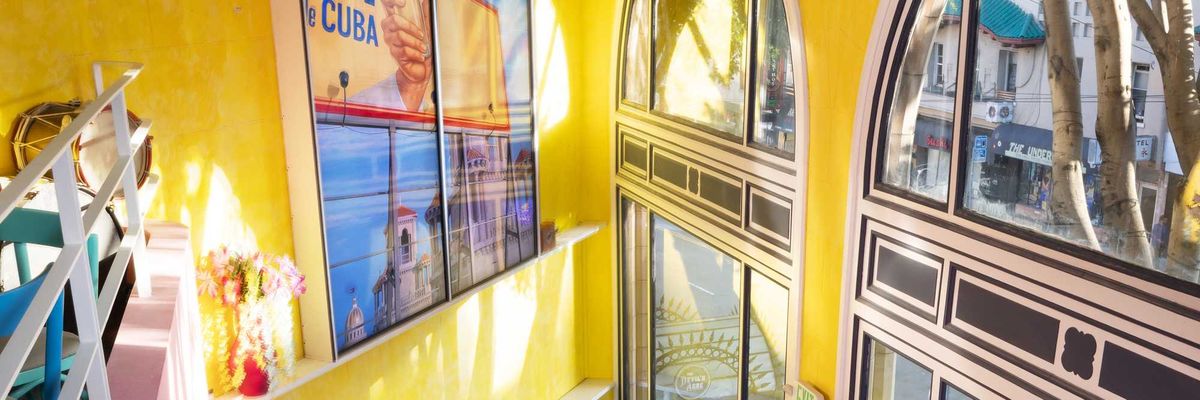You’ll want to settle into one of the comfy easy chairs and poke around the selections in the listening stations for a good long while at the “Jews on Vinyl” exhibit, up through this spring at the Contemporary Jewish Museum.
Peruse a worn copy of the show’s inspiration, Roger Bennett and Josh Kun’s And You Shall Know Us by the Trail of Our Vinyl: The Jewish Past as Told by the Records We Have Loved and Lost, and lend an ear to Eartha Kitt’s, Nat King Cole’s, Nina Simone’s, Arthur Lyman’s, and, ahem, Charleston Heston’s takes on sacred songs and tunes by Jewish songwriters: You’ll discover some great songs, as well as curiosities and eye-openers. It’s an enlightening mix that focuses on an all-too-neglected slice of Jewish pop history.
Inspired, I caught up with co-curator Kun, a onetime Bay Guardian music columnist and current associate professor at the Annenberg School for Communication and the Department of American Studies and Ethnicity at the University of Southern California, via e-mail.
Q: How did the book and exhibit come to pass?
Josh Kun: The book grew out of my work with my partners in the Idelsohn Society for Musical Preservation. Since starting as a nonprofit record label in 2005, we have been dedicating ourselves to the excavation of lost treasures of Jewish American music that allow us to rethink dominant models of Jewish American history. Our motto has always been: “History sounds different when you know where to start listening.”
In gathering material for the label, we began to amass a large collection of LPs, most of which we were finding at garage sales, thrift stores, and swap meets (including that great swap meet in the sky, eBay), and we realized we had something pretty remarkable. We then began filling in some of the blanks with the help from the wonderful Judaica Sound Archives down in Boca Raton -- their collection of Jewish LPs is astounding.
The idea for the exhibition followed soon after and grew out of conversations we began to have with Connie Wolf of the CJM who was really the one who had the vision to pull the show off.
Q: Did you encounter any specific collections or records -- or tangle with particularly intriguing collectors along the way?
JK: The vinyl featured in the book and the exhibition was the cumulative result of collecting that started back in the mid-’90s, and most of it was found in places where vinyl goes to die. This has been a rescue mission, driven by our belief that within these forgotten bits of history lay valuable stories that have gone untold.
Q: What do you consider the golden age of Jewish recording -- and why?
JK: That really depends on how you define “Jewish recording” and “Jewish music,” both phrases that have been the subject to decades, if not centuries, worth of debates. But for me, personally, I love the early years of the commercial recording industry, the birth of Tin Pan Alley, when so many immigrant Jewish songwriters were using music and the industry of music to negotiate their relationship to an America that wasn’t very comfortable with them.
Q: What were your most important or meaningful discoveries in the process of collecting?
JK: Finding just how vast, wide-ranging, and deep the archive of Jewish American music is. I think most people hear “Jewish music” and think only of either klezmer or cantorial music, but what we found over and over is that the story of Jews making music in America is such a complex, varied, and culturally diverse story, one that leads to virtually all styles and genres in the American pop spectrum and one that has only recently begun to be told and understood.
Q: Why do you think there was such an outpouring of Jewish song from non-Jewish artists?
JK: Jewish songwriting has been a backbone of American popular music from day one, so there have always been Jews rubbing elbows with everybody else, not to mention all of the Jewish managers, nightclub owners, and label chiefs. Throughout the 20th century, the story of the Jews as a marginalized culture struggling against oppression while on the road to liberation and uplift has also -- at times -- aligned Jews with the sorrows and striving of other minority groups, so there has long been examples of exchange and influence. Either that or “Hava Nagila” is just that good of a song.
Q: What are the most interesting or provocative interpretations of Jewish music by non-Jewish artists here?
JK: My favorite is probably Jon Yune’s 1970s LP of Yiddish and Hebrew songs, Ose Shalom. Yune, who is best known as the star of the Bruce Lee spoof They Call Me Bruce, came to the US from Korea, started his singing career in Jewish cabarets in New York in the ‘60s, and released his one and only album that was a tribute to his love of Jewish music and his Jewish friends. When I met him in Koreatown in L.A. he told me that he still sings “Exodus” during his act because he connects the song’s tale of the Jewish struggle for statehood to the history of his own people under Japanese rule.
Q: What record do you most value -- and why?
JK: Probably Mickey Katz’s Mish Mosh. It’s a testament to Katz’s genius as a Jewish parodist of American culture, a real masterpiece of musical comedy. I think that learning about Katz was responsible for my interest in collecting and archiving. His music opened the door for me to an alternative history of Jewish American musical history, one that is radical, anti-assimilationist, and still profoundly fun. He started the avalanche for me.
Q: Why was there such a simpatico connection between Latin sounds and artists and Jewish material and themes?
JK: That’s a big question with a really long answer, but here’s a short version: They often lived side by side in New York neighborhoods. Jews were huge mambo fans. Latinos played plenty of Jewish weddings and bar mitzvahs. Catskills resort owners were some of the greatest advocates and promoters of Latin music in the ‘40s and ‘50s. Yiddish and Latin radio shows often aired next to each other on the same radio stations. I think, in part, what attracted Jews so much to Latin music was that it offered them a way to be American without losing their Jewishness, new musical languages that allowed them to rewrite Jewish identity -- for example, there are tons of Jewish Latin albums that feature Yiddish tunes set to Latin rhythms.
Q: Why did the Jewish record market languish?
JK: It has a lot to do, I think, with the status of Jews in the mix of American culture. There was a time when putting out explicitly Jewish material resonated with Jewish audiences, and then there have been plenty of times when Jewish audiences wanted to buy anything but Jewish material. After the trauma of World War II, the idea of maintaining any kind of Jewish difference from the mainstream was not a road many American Jews were interested in pursuing.
Q: Tell me about the next related installment at the museum?
JK: We are organizing an exhibition inspired by our forthcoming compilation, Black Sabbath, a musical guide to Black-Jewish relations that features African American artists like Aretha Franklin, Nina Simone, the Temptations, and Johnny Mathis performing Jewish material.
Q: What sort of response has the book -- and exhibit -- received? Do you think the work will open the eyes of a new generation of musicmakers and listeners?
JK: We have been really thrilled by the reception to both. Everywhere we go we meet people who share their stories with us, give us their LPs, connect us to musicians and collectors who can help. With the exhibition, I think people are enjoying the opportunity to sit with the music, to hold the LPs, and listen to songs in a living room. We really tried to make these LPs come alive as living material, and people can sit and quietly reflect on what they see and hear.
Q: Will “Jews on Vinyl” travel?
JK: It opens later this spring at the Skirball Cultural Center in Los Angeles.
Q: What's coming up next for you?
JK: After the release of Black Sabbath, we will be organizing a series of big concert events in San Francisco, New York, and Los Angeles that all unite veteran musicians with younger artists. In the winter, we will also be releasing a collection of ‘60s and ‘70s Israeli psych-rock, a kind of “Jewish Nuggets.” And all year long we are traveling the country to record detailed video testimonies of veteran Jewish American musicians, which will be available for viewing on our Web site, idelsohnsociety.com.
"Jews on Vinyl" runs through spring at Contemporary Jewish Museum, 736 Mission St., SF. Hours are 11 a.m.-5:30 p.m. Fri.-Tues., 1-8:30 p.m. Thurs. $8-$10. (415) 655-7800, www.thecjm.org




















